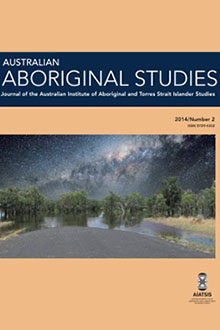Australian Aboriginal Studies: Issue 2, 2014
Abstracts for Issue 1, 2014
The astronomy of the Kamilaroi and Euahlayi peoples and their neighbours
Robert S Fuller, Ray P Norris and Michelle Trudgett
The Kamilaroi people and their neighbours, the Euahlayi, Ngemba and Murrawarri, are an Aboriginal cultural grouping located in north-west and north central New South Wales. They have a rich history, but have been missed in much of the literature concerning sky knowledge in culture. This study collected stories, some not previously reported in an academic format, from Aboriginal people practising their culture, augmented with stories from the literature, and analysed the data to create a database of sky knowledge that will be added to the larger body of Aboriginal cultural knowledge in Australia. We found that there is a strong sky culture reflected in the stories, and we explored the stories for evidence of an ethnoscientific approach to knowledge of the sky.
Notice to Aboriginal and Torres Strait Islander readers: This paper contains the names of people who have passed away, and refers to events, such as massacres, which may be upsetting.
The Aboriginal Mothers in Prison project: an example of how consultation can inform research practice
Mandy Wilson, Jocelyn Jones and Marisa Gilles
Aboriginal and Torres Strait Islander1 women comprise the fastest growing subgroup among the prisoner population and are severely over-represented in Australian prisons. Despite the striking over-representation, research into their health and other needs has, to date, been limited. This paper describes the consultation process undertaken in Western Australia for the Social and Cultural Resilience and Emotional Wellbeing of Aboriginal Mothers in Prison project (hereafter, the Aboriginal Mothers in Prison project). The project aims to better understand the health, treatment and other needs of Aboriginal mothers in prison in Western Australia and New South Wales, and was conducted over two phases, the consultation phase and the applied research phase. This paper focuses on the results of the first phase of the research. It outlines the history of the development of ethics in this field and reviews the formal documents available to guide researchers working with Aboriginal and Torres Strait Islander peoples, tenets of which were infused throughout the research process. The paper then discusses how key stakeholders were identified in the area and provides an overview of the central findings from the consultation phase. In addition, the paper illustrates how being true to the consultation process and actively incorporating the feedback of diverse (and sometimes competing) stakeholders ensures the project acknowledges, respects and actions (where possible) the needs and concerns of the various agencies and individuals with investment in the issue.
‘Game over’: Indigenous Australian sportsmen and athletic retirement
Megan Stronach, Daryl Adair and Tracy Taylor
In Australia, three sports in particular — boxing, rugby league and Australian Rules football — have attracted many Indigenous1 competitors, both in professional and elite amateur ranks. This paper investigates the retirement experiences of Indigenous Australian sportsmen; in doing so, it explores a significant gap in knowledge. There is no body of research into the athletic retirement of elite Indigenous athletes, thus very little is known about how they have prepared for and adjusted to a life after competing in sport. The study analyses the roles and responsibilities of sport organisations in terms of athletic retirement planning, since these bodies arguably have a duty of care to their employees and, in the case of player associations, to their members. The research is underpinned by an Indigenous philosophy known as Dadirri, which emphasises deep and respectful listening, and the concern is to understand policy and practice in respect of athletic retirement. The study concludes that Indigenous Australian sportsmen face complex postsport challenges due to (a) the primacy of their athletic identity, (b) assumptions about their ‘natural’ acumen as athletes, (c) the impact of racialised stereotypes, and (d) profound commitments to extended families and communities. Athletic retirement is therefore likely to be particularly challenging for Indigenous sportspeople. Consequently, providers of athlete career and education programs need to develop policies and provide resources that cater for the complex transition needs of Indigenous athletes.
The influence of the US Black Panthers on indigenous activism in Australia and New Zealand from 1969 onwards
Angelique Stastny and Raymond Orr
The means by which ideologies are spread is of growing interest to scholars. In comparative indigenous studies, much attention has been given to the political links that developed throughout the mid to late-twentieth century between activist organisations that sought greater freedom and rights for indigenous or racially marginalised populations. This paper looks at the early contact between American Black Panthers and indigenous activist organisations in Oceania in the 1960s and ’70s. It illustrates how various ideological frameworks, such as colour consciousness, and confrontational strategies, such as takeovers, were exchanged during this period. This interaction suggests that Australian and New Zealand indigenous organisations, borrowing from American activists, adapted ideologies and strategies that worked within their local political contexts.
Community reconciliation: a case study in Gippsland, Victoria
Andrew Gunstone
In the history of the reconciliation movement in Australia over the past 20 years, the involvement of local communities has been a substantial component of the movement. In this paper, I demonstrate the significance of this involvement through exploring a case study in Gippsland, Victoria. I analyse the racist and ignorant attitudes held by many in the wider community in Gippsland concerning Indigenous people. I then explore several examples of the Gippsland community working for reconciliation. I have selected examples to illustrate each of the key components of reconciliation. These key components are outlined in this paper: recognising Indigenous rights; educating the wider community; addressing history; community involvement; and addressing Indigenous socio-economic disadvantage.
